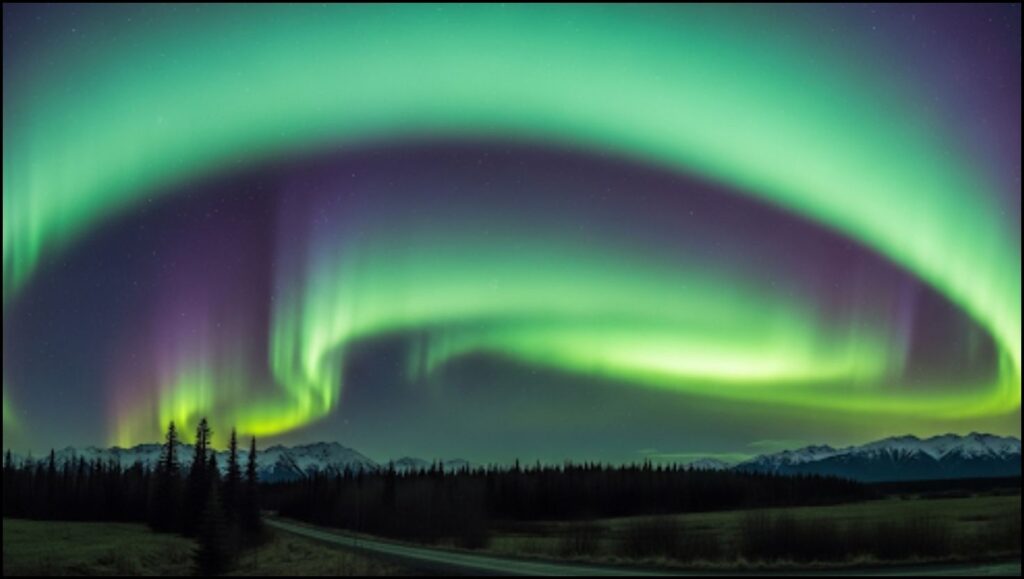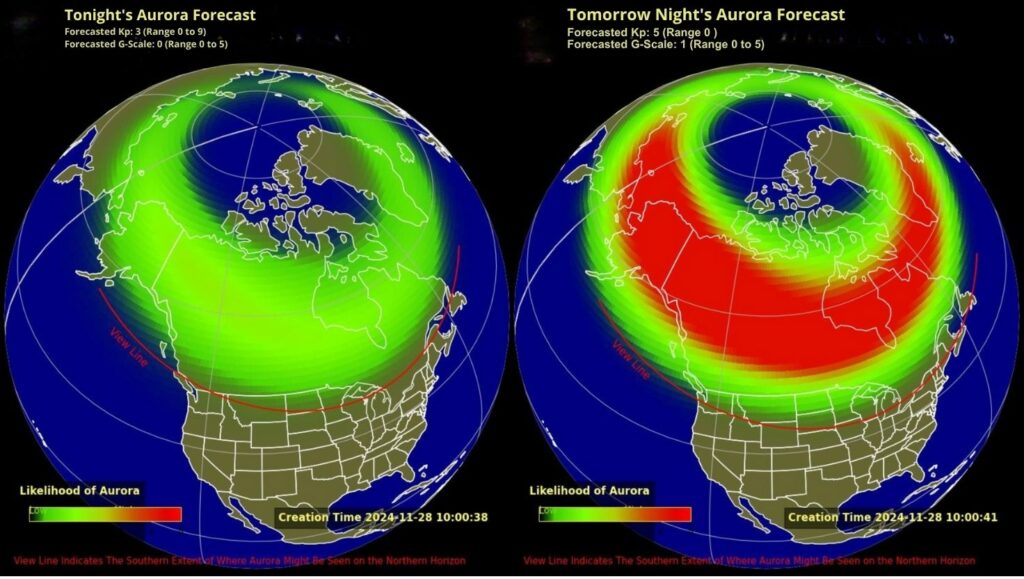A moderate geomagnetic storm is expected to make the Northern Lights visible in a rare display across much of the northern United States tonight, with forecasters predicting a spectacular show for residents in as many as 18 states. The aurora borealis is the result of a coronal mass ejection (CME) from the sun impacting Earth’s magnetic field, pushing the celestial light show far south of its typical polar range.

Geomagnetic Storm Spurs Rare Northern Lights Event
| Key Fact | Detail/Statistic |
| Event | Geomagnetic storm, G2 on a scale of 1-5 |
| Peak Viewing Time | Best chance is from 2 a.m. to 5 a.m. EDT tonight |
| Affected States | 18 U.S. states, including those as far south as Illinois, Iowa, and Nebraska |
| Viewing Tips | Find a dark, north-facing location away from city lights |
The National Oceanic and Atmospheric Administration’s (NOAA) Space Weather Prediction Center (SWPC) has issued a G2 (moderate) geomagnetic storm watch, indicating that the aurora oval—the region where auroras are most likely—will expand significantly southward. This expansion makes the vibrant display accessible to a much broader audience than usual. The storm is linked to a solar flare and subsequent coronal mass ejection that erupted from a sunspot earlier this week. While the exact timing of the CME’s arrival is difficult to pinpoint, its effects are expected to be most pronounced late tonight into the early morning hours.
What Causes the Aurora Borealis?
The northern lights, or aurora borealis, are a natural phenomenon caused by the interaction of charged particles from the sun with Earth’s magnetic field and upper atmosphere. Solar winds carry these particles toward our planet, where they are typically deflected by the magnetosphere. However, during a geomagnetic storm, the influx of particles is so strong that some are able to penetrate the magnetic field, particularly at the poles.
“Think of it like a cosmic collision,” said Dr. Jane Foster, a senior space physicist at the University of Alaska, Fairbanks, in an interview. “The charged particles from the sun are traveling at incredible speeds. When they hit the gases in our atmosphere, like oxygen and nitrogen, they excite those gas atoms, which then release energy in the form of light. The colors we see—greens, reds, and blues—depend on which gases are being excited and at what altitude.”
The intensity of the aurora is measured using the Kp-index, a scale from 0 to 9 that reflects global geomagnetic activity. A low Kp-index of 0 to 2 corresponds to a quiet, undisturbed magnetic field, while a Kp-index of 5 or higher signals a geomagnetic storm. According to NOAA’s forecast, the Kp-index is expected to peak at 6 tonight, a level consistent with G2 storm conditions, which is why the aurora is projected to be visible from mid-latitudes.
Where and When to See the Northern Lights
For those in the United States, the opportunity to see the aurora borealis is a relatively rare event outside of Alaska. Tonight’s forecast offers a significant chance for millions to witness the spectacle, but successful viewing depends heavily on location and sky conditions.
The 18 states with the highest probability of a good view include:
- Alaska
- Montana
- North Dakota
- Minnesota
- Wisconsin
- Michigan
- Maine
- South Dakota
- Vermont
- New Hampshire
- Idaho
- Washington
- Oregon
- New York
- Wyoming
- Iowa
- Nebraska
- Illinois
This list is based on NOAA’s Aurora Viewline forecast, which maps the southern boundary of potential visibility. Residents in these states should prioritize finding a viewing location with minimal light pollution and a clear, unobstructed view of the northern horizon. The best time to look for the northern lights will be between 2 a.m. and 5 a.m. local time, when geomagnetic activity is forecast to be at its highest.

Tips for Optimal Viewing and Photography
Even with a strong geomagnetic storm, viewing the aurora is not guaranteed. Weather conditions, particularly cloud cover, are a critical factor. For those under clear skies, experts recommend the following tips:
- Move Away from City Lights: Light pollution from urban areas can easily overpower the often-faint glow of the aurora. Rural areas, open fields, and parks are ideal.
- Face North: The aurora will be most prominent along the northern horizon.
- Be Patient: Auroras can appear and fade, so a continuous period of observation is often required. The most intense displays, known as “auroral substorms,” can last from a few minutes to an hour.
- Use Technology: Various smartphone apps and websites, including the NOAA SWPC’s real-time aurora forecast, provide data on current geomagnetic activity and the aurora’s location.
For photography enthusiasts, capturing the aurora requires a camera with manual settings, a wide-angle lens, and a tripod. A long exposure time of 10-20 seconds and a high ISO setting (800-3200) can help the camera sensors capture the light that may be too faint for the naked eye.
The current event is a vivid reminder of the dynamic relationship between the sun and Earth. As solar activity ebbs and flows in its 11-year cycle, more powerful events and resulting celestial light shows are expected. Tonight’s display offers a rare opportunity for a large portion of the North American population to connect with a cosmic event typically reserved for those in higher latitudes.
Powerful Geomagnetic Storm to Create Widespread Northern Lights Display During Full Sturgeon Moon
